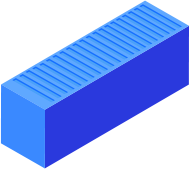SHIPPING CONTAINER SPECIFICATIONS
Typical ISO (International Standards Organization) shipping containers are manufactured with identical size specification in terms of exterior height, exterior width, and exterior length. The standardization of containers and the adoption of the ISO shipping container specifications is to ensure that all equipment handlers, chassis, rail cars, and slot spaces on vessels will accommodate ALL containers.
-

20’ - 8’6”
-

40’ - 8’6”
-

40’ - 9’6”
The following table defines the size and types of containers available within BAL fleet.
| 20’ - 8’6” | 40’ - 8’6” | 40’ - 9’6” | |
|---|---|---|---|
| General Purpose | x | x | x |
| Open Top | x | x | |
| Flat Rack | x | x | |
| Reefer | x | x |
- General Purpose
- Reefer Containers
- Open top Containers
- Flat-rack Contaners
- 20’ - 8’6”
- 40’ - 8’6”
- 40’ - 9’6”
| Size and Type grouping code | 20GP | Nominal capacity (cu.m.) | 33.2 |
| Dimensions & type code | 22G1 | Maximum gross weight (kg) | 30,480 |
| Internal dimensions | Average tare (kg) | 2,230 | |
| Length (mm) | 5,900 | Maximum payload (kg) | 28,250 |
| Width (mm) | 2,352 | Height (mm) | 2,393 |
| Size and Type grouping code | 40GP | Nominal capacity (cu.m.) | 67.8 |
| Dimensions & type code | 42G1 | Maximum gross weight (kg) | 30,480/32,500 |
| Internal dimensions | Average tare (kg) | 3,720 | |
| Length (mm) | 12,034 | Maximum payload (kg) | 26,760/28,780 |
| Width (mm) | 2,352 | Height (mm) | 2,395 |
| Size and Type grouping code | 40HC | Nominal capacity (cu.m.) | 76.4 |
| Dimensions & type code | 45G1 | Maximum gross weight (kg) | 30,480/32,500 |
| Internal dimensions | Average tare (kg) | 3,900 | |
| Length (mm) | 12,034 | Maximum payload (kg) | 26,580/28,600 |
| Width (mm) | 2,352 | Height (mm) | 2,700 |
Definition:A freight container, totally enclosed and weatherproof, with a rigid roof, ri- gid side walls, and floor, having at least one of its end walls equipped with doors and intended to be suitable for the transport of a variety of cargoes.luding those packed in boxes, cartons, cases, bags, bales, pallets, drums etc... With some suitable adaptations, such as liner bags, flexi-tanks, etc.) and adequate loading/unloading equipment, this type of container may also be used for certain types of bulk cargo (dry and liquid)
- 20’x8’x8’6”
- 40’x8’x9’6”
| Size and Type grouping code | 20RF | Nominal capacity (cu.m.) | 28.6 |
| Dimensions & type code | 22R1 | Maximum gross weight (kg) | 30,480 |
| Internal dimensions | Average tare (kg) | 3,010 | |
| Length (mm) | 5,456 | Maximum payload (kg) | 27,470 |
| Width (mm) | 2,294 | Capacity in use (cu.m.) | 27.3 |
| Height (mm) | 2,273 | Height usable for cargo (mm) | 2,158 |
| Size and Type grouping code | 40RH | Nominal capacity (cu.m.) | 68 |
| Dimensions & type code | 45R1 | Maximum gross weight (kg) | 34,000 |
| Internal dimensions | Average tare (kg) | 4,700 | |
| Length (mm) | 11,584 | Maximum payload (kg) | 29,300 |
| Width (mm) | 2,294 | Capacity in use (cu.m.) | 64.9 |
| Height (mm) | 2,557 | Height usable for cargo (mm) | 2,394 |
- 20’x8’x8’6”
- 40’x8’x8’6”
| Size and Type grouping code | 20 OT | Dimensions & type code | 22U1 |
| Internal dimensions | Length (mm) | 5,898 | |
| Width (mm) | 2,352 | Height (mm) | 2,348 |
| Door opening | Height under top-rail (mm) | 2,200 | |
| Top Opening dimensions | Length between end lintels (mm) | 5,682 | |
| Width between gussets (mm) | 1,840 | Length between end gussets (mm) | 5,397 |
| Width between roof rails (mm) | 2,252 | 1,940 | |
| Nominal capacity (cu.m.) | 32 | Maximum gross weight (kg) | 30,480 |
| Average tare (kg) | 2,200 | Maximum payload (kg) | 28,280 |
| Size and Type grouping code | 40 OT | Dimensions & type code | 42U1 |
| Internal dimensions | Length (mm) | 12,032 | |
| Width (mm) | 2,352 | Height (mm) | 2,348 |
| Door opening | Height under top-rail (mm) | 2,000 | |
| Top Opening dimensions | Length between end lintels (mm) | 11,806 | |
| Width between gussets (mm) | 1,650 | Length between end gussets (mm) | 11,531 |
| Width between roof rails (mm) | 2,232 | 1,940 | |
| Nominal capacity (cu.m.) | 66 | Maximum gross weight (kg) | 30,480 |
| Average tare (kg) | 3,880 | Maximum payload (kg) | 26,600 |
- 20’x8’x8’6”
- 40’x8’x8’6”
| Size and Type grouping code | 20PC | Dimensions & type code | 22P3 |
| Internal dimensions | Length between end headers (mm) | 5,920 | |
| Length between corner posts (mm) | 5,634 | Width between corner posts (mm) | 2,224 |
| Width of floor (mm) | 2,208 | Height (mm) | 2,213 |
| Maximum gross weight (kg) | 34,000 | Average tare (kg) | 2,750 |
| Maximum payload (kg) | 31,250 |
| Size and Type grouping code | 40PC | Dimensions & type code | 42P3 |
| Internal dimensions | Length between end headers (mm) | 12,054 | |
| Length between corner posts (mm) | 11,652 | Width between corner posts (mm) | 2,227 |
| Width of floor (mm) | 2,374 | Height (mm) | 1,959 |
| Maximum gross weight (kg) | 45,000/50,000 | Average tare (kg) | 4,900/5,100 |
| Maximum payload (kg) | 40,100/44,900 |
-

General Purpose
-

Reefer Containers
-

Flat-rack Contaners
-

Open top Containers
Flat-rack Contaners
Cargo weight must be evenly spread over the largest possible floor area.
Center of gravity of the cargo is to be as close as possible to the container center and as low as possible. The higher the center of gravity, the higher must be the wedging devices.
The cargo load units must support (be in contact with) each other with no large gaps in between and must be secured to the container (wedges, lashings, etc.) so that they cannot move nor collapse.
All containers are fitted with several lashing rings and bars.
If the cargo load units are not homogeneous the heaviest ones must be on floor level and the lighter ones on top (and liquid ones underneath solid ones).
The maximum gross mass/weight of the container (usually marked as “Max gross” on the container right hand side door) must never be exceeded (there are also maximum limits re- lated to different local inland transport regulations). It is illegal for cargo weight to exceed the net weight (payload) value marked on same right hand side door.
Cases of concentrated cargo load.
As per rule 1, the cargo must lay over as many floor cross members as possible so that the weight distribution is as close as possible to the ideal one based on container max payload value and length. For instance the limit for a 20GP is about 5T per linear meter (based on max payload 28T, length 6 m). The below basic guideline can be used:
Whenever necessary the cargo must be put on some additional supports / longitudinal members to comply with above recommendations.
Center of gravity of the cargo is to be as close as possible to the container center and as low as possible. The higher the center of gravity, the higher must be the wedging devices.
The cargo load units must support (be in contact with) each other with no large gaps in between and must be secured to the container (wedges, lashings, etc.) so that they cannot move nor collapse.
All containers are fitted with several lashing rings and bars.
If the cargo load units are not homogeneous the heaviest ones must be on floor level and the lighter ones on top (and liquid ones underneath solid ones).
The maximum gross mass/weight of the container (usually marked as “Max gross” on the container right hand side door) must never be exceeded (there are also maximum limits re- lated to different local inland transport regulations). It is illegal for cargo weight to exceed the net weight (payload) value marked on same right hand side door.
Cases of concentrated cargo load.
As per rule 1, the cargo must lay over as many floor cross members as possible so that the weight distribution is as close as possible to the ideal one based on container max payload value and length. For instance the limit for a 20GP is about 5T per linear meter (based on max payload 28T, length 6 m). The below basic guideline can be used:
Whenever necessary the cargo must be put on some additional supports / longitudinal members to comply with above recommendations.





